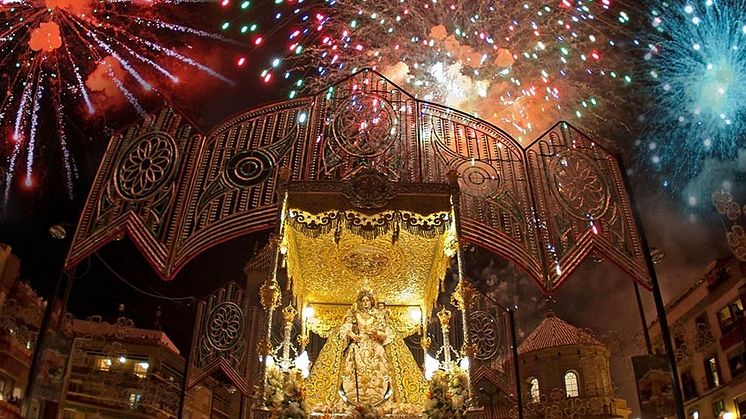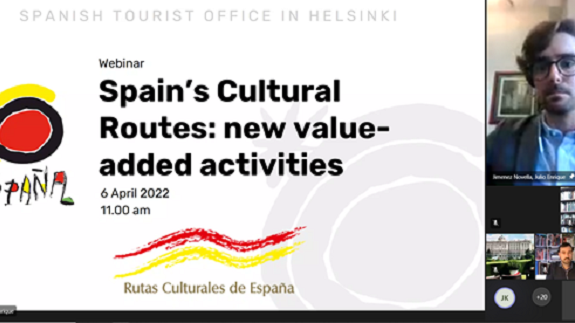Press release -
New webinar organised by the Spanish Tourist Office about Spain’s Cultural Routes

The Spanish Tourist Office in Helsinki, in collaboration with SMAL and Cultural Routes in Spain, has organised the webinar Spain’s Cultural Routes: new value-added activities, which took place on 6 April 2022 and was aimed at Finnish travel professionals.
Cultural Routes in Spain is a tourist brand endorsed by the Secretary of State for Tourism and Trade of the Government of Spain. It currently links five physical and thematic Spanish routes that comprise a representative and thematic sample of the territorial and cultural diversity of the country. These routes are managed by non-profit organisations formed by public and private institutions working in culture and tourism: International Association “Caminos de Arte Rupestre Prehistórico”, Cooperation Network of Towns on the Ruta de la Plata, Way of El Cid Consortium, Cooperation Network of the Routes of Emperor Charles V and Association of the Tourist Development of the Ways of Passion.
Spain offers high-quality tourism options that attract millions of people from all over the world every year. Apart from the well-known places associated with the country, a fascinating Spain exists, of extraordinary diversity and great historic, artistic, natural and ethnographic wealth resulting from the different civilisations that have lived in this land over the centuries. The Cultural Routes in Spain are an invitation to explore this wealth in the country through different cultural itineraries that cross it from north to south and from east to west. Travelling along any of these routes is a journey to the heart of the history of Spain, its culture and its people. These tours are the perfect way to visit Spain if you’re interested in its culture and history. They trace long routes through large areas to reveal the legacy of the many civilisations which have made their home here.
During the webinar, Finnish travel professionals were able to learn more about the five routes thanks to the presentation made by the experts from each route, which included images, videos, maps and useful information on a part of Spain that is not so well-known among the Finnish population.
Among the routes showcased, we could highlight:
The Vía de la Plata (Silver Route)
This was the main road of the Roman Empire in Spain. It connected the north and south of Roman Hispania, and today leads to fascinating destinations like Seville, Cáceres, Salamanca, León, Gijón and Mérida. This last city holds one of the world’s best-conserved Roman archaeological complexes, now a UNESCO World Heritage site, one of many along the route, including the monuments of Seville, Cáceres, León and Salamanca.
You can retrace the last journey of the Holy Roman Emperor Charles V on this route through the regions of Cantabria, Castilla y León, and Extremadura. The itinerary begins in Laredo (Cantabria), where the Emperor arrived in 1556 at the start of his journey to the Monastery of Yuste (in Cuacos de Yuste, Extremadura). Here he would spend his last days, retired from public life.
Tradition, art and popular culture mark this route through inland Andalusia, in southern Spain. Follow the path to discover 10 villages in the provinces of Jaén, Cordoba and Seville. You can take part in Easter rituals that involve whole towns, discover ancestral crafts and enjoy the flavours of traditional local dishes.
The world’s first art gallery! Here you can see the art of the earliest Europeans. We’re talking about Altamira and the Palaeolithic cave paintings of the Cantabrian coast, which together form a UNESCO World Heritage site, but there are many more caves, shelters and megalithic constructions in almost all of Spain where you can see art created by our distant ancestors
This literary and historical route follows the footsteps of the legendary Cid Campeador, the hero of the famous 12th-century Castilian poem, “Cantar de Mío Cid”. The route passes through the regions of Castilla y León, Castilla-La Mancha, Aragon and Valencia, where you can visit UNESCO World Heritage sites such as Burgos Cathedral, the Mudéjar architecture of Aragon, and the Palm Grove of Elche, as well as many natural spaces.

Fiestas Arcelitanas in Lucena. Cordoba © Turismo Ayuntamiento de Lucena. Miguel Cantero
You can learn more about these routes on https://www.spainculturalroutes.com/en/ and in https://www.spain.info/en/top/cultural-routes-in-spain/
If you have any questions, please contact us at helsinki@tourspain.es

